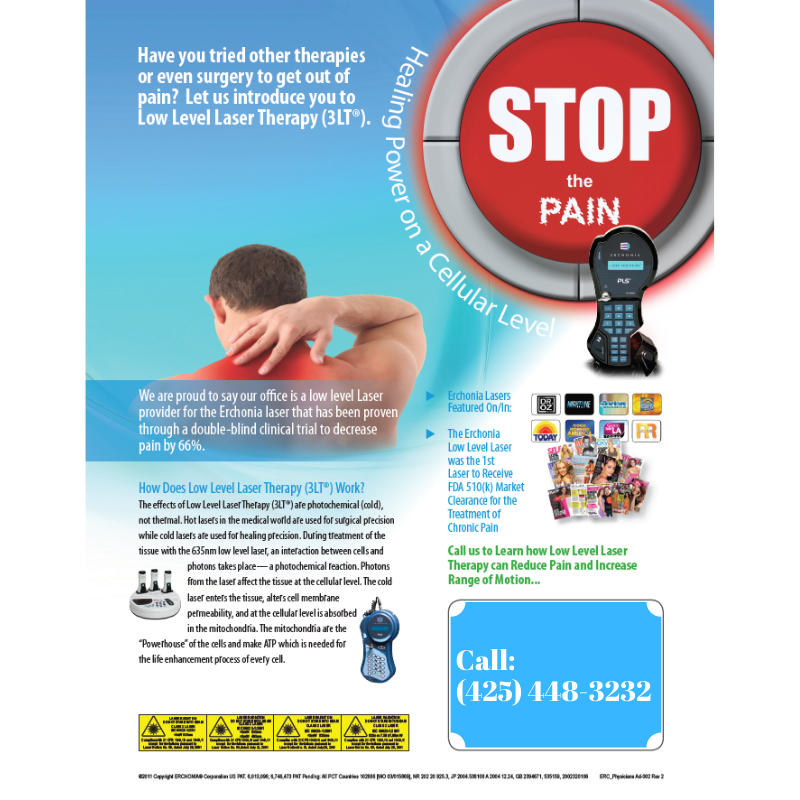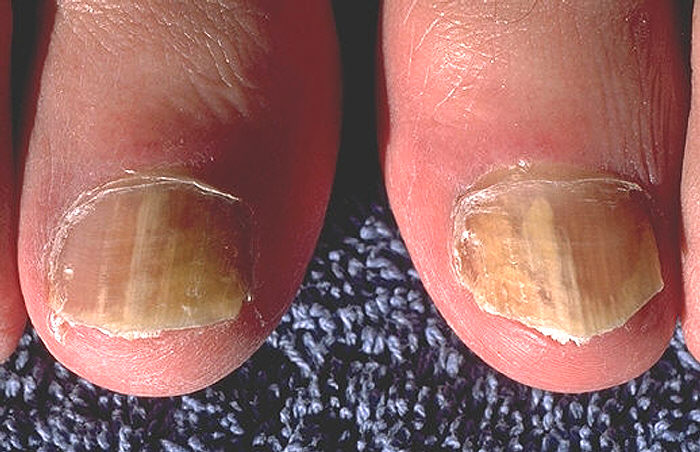What is low‐level laser therapy?
Low‐level laser therapy (LLLT) is a therapeutic strategy that addresses a particular medical ailment in a diverse and multifactorial manner. Laser therapy is not a unilateral tool, it does not simply suppress pain nor does it just increase range of motion, it restores functionality and improves quality of life by resolving all underlining causes. For instance, shoulder pain generally arises from a single traumatic event, and as a means to prevent aggravation of the injured tissue your body will restrict movement, decreasing neuropeptide release and restricting blood and oxygen flow along the injured site. Laser therapy, by stimulating both the nervous system and site of tissue injury, has been clinically proven to suppress
inflammation, increase oxygen and blood flow, promote muscle calcium uptake, and increase neurotransmitter release. By addressing the injury with a diverse tool it is possible to resolve the condition more effectively by suppressing not one contributor but all contributors.
How does LLLT work?
Low‐level laser therapy operates under a principle of science known as photochemistry, and as the name implies, is the modulation of chemical and biochemical reactions through the absorption of photons, or light energy. Housed within the mitochondria, the cell energy manufacturer, are receptors capable of absorbing distinct parameters of light. Think of these receptors like any drug receptors. When we consume a prescription medication, the compound is absorbed by the body and it locates a particular receptor, and based upon its molecular design, will bind to that receptor. Once the drug binds a secondary reaction inside the cell takes place. A similar mechanism is observed when exposing the body to a particular color of light. During a treatment the light will penetrate the skin and is absorbed by this receptor within the mitochondria. Receptor stimulation with light promotes energy production, biochemical reactions, protein and growth factor synthesis, cell growth and proliferation, enhanced blood and oxygen flow, and prevents cell death. When one understands a wound environment, having the capability to address multiple cellular impairments with one therapeutic modality enhances recovery and restoration in the quality of life.

How does laser therapy strengthen muscle?
Skeletal muscle tissue is capable of aerobic and anaerobic respiration, requiring glycolysis, the Kreb cycle, and oxidative phosphorylation to produce Adenosine Triphosphate (ATP). Utilizing these complex pathways demands a regular supply of oxygen and nutrients, and as we participate in extensive exercise these components can become depleted. When a muscle contracts the central stimuli originates from
the central nervous system transitioning to the peripheral nervous system which innervates the target muscle promoting contracture via the release of a neurotransmitter. Subsequent the release of neurotransmitters a secondary reaction cascade is stimulated which promotes skeletal muscle calcium influx inducing muscle contracture. An integrative network of neurons and biochemical pathways are responsible for muscle strength and integrity; ultimately, any modulation in one of these pathways could dramatically impact functionality. The application of low‐level laser therapy has been clinically proven to not only increase range of motion in patients suffering with acute and chronic pain but also reduced the overall pain experienced by the patient after one application. Delivering specific parameters of light can increase ATP production, promote calcium influx, and support proper nervous system function and neurotransmitter release. As a simple acute injury can modulate muscle function resulting in a chronic pain state, the application of laser can support muscle strength and improve range of motion by preventing tissue plasticity.
How long does it last?
Low‐level laser therapy is a multifactorial approach and when partnered with neuromusculoskeletal techniques the therapeutic strategy can potentially address the underlining condition and results can last until the tissue is re‐aggravated. Clinical studies demonstrate that the positive outcomes associated with laser therapy are immediate and can last many weeks but like many therapies laser requires numerous treatments to effectively resolve the underlining etiologies responsible for producing pain. Treating the point of injury can dramatically improve blood and oxygen flow, downregulate proinflammatory cytokines, and promote muscle activation and strength, but if the injury is not resolved inevitably these beneficial components will become overwhelmed and the pain will return. Coupled
with preventive care a treatment series with low‐level laser therapy delivered by a trained professional can generate long‐term results.
How quickly does LLLT work?
Even though one treatment can impact cell proliferation, protein synthesis, increase blood and oxygen flow, and activate as well as strengthen muscle tissue if the required amount of time for complete resolution these outcomes will only be temporary. With any condition a multifactorial deficiency is often responsible for the clinical pain and therefore a multifactorial therapeutic approach is required, and if one aspect is addressed leaving many more untreated, then complete resolution is not possible. This principle is common across all disciplines of medicine, if a patient suffers from a bacterial infection; the ingestion of one anti‐bacterial tablet will have some benefit but will have no means of eradicating the entire bacterial colony. Although the literature supports that one treatment of laser therapy can generate a significant improvement in pain, for long‐term pain relief multiple treatments are essential. We recommend a series of 6 treatments for best outcome.
If LLLT sounds like it could be right for you, call (425) 448-3232 to schedule an appointment with Dr. McManus.
Learn more about cold laser here. The Erchonia website has also posted some of the clinical research on low-level laser therapy.
